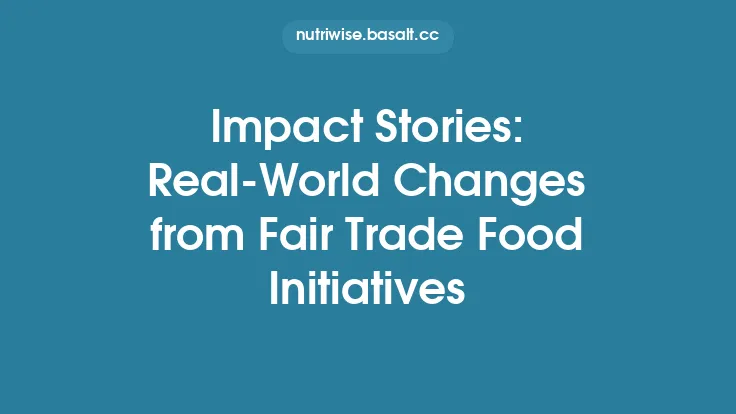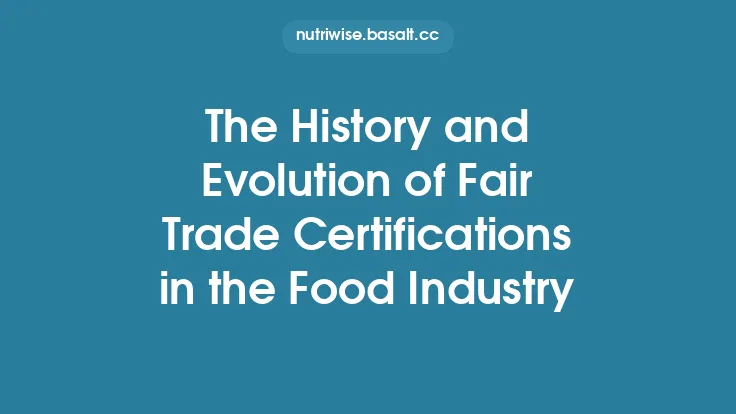Fair trade emerged as a response to the systemic inequities that have long plagued agricultural supply chains, particularly in the food sector. By establishing a set of internationally recognized standards, fair trade creates a protective framework that safeguards the rights, health, and dignity of food workers across the globe. This protection is not a single‑dimensional guarantee; it is built upon a network of interrelated mechanisms that address labor rights, workplace safety, gender equity, skill development, and community resilience. Understanding how these mechanisms function together provides a clear picture of why fair trade remains a cornerstone of ethical food production.
Core Principles of Fair Trade Protection
At the heart of fair trade lies a set of principles that translate into concrete protections for workers. While the concept of a “fair price” often receives the most public attention, the broader framework includes:
- Respect for Fundamental Labor Rights – Fair trade standards explicitly require compliance with core International Labour Organization (ILO) conventions, covering freedom of association, collective bargaining, prohibition of forced labor, and elimination of child labor.
- Safe and Healthy Working Conditions – Employers must implement occupational health and safety (OHS) protocols that meet or exceed national regulations, including provision of protective equipment, safe handling of agro‑chemicals, and emergency response plans.
- Gender Equality and Non‑Discrimination – Standards mandate equal treatment regardless of gender, ethnicity, or other protected characteristics, and they promote the participation of women in decision‑making bodies.
- Capacity Building – Fair trade encourages continuous training in both technical agricultural practices and workers’ rights, fostering long‑term resilience.
- Community Investment – A portion of the premium paid for fair trade products is earmarked for community projects that indirectly benefit workers, such as water infrastructure, schools, and health clinics.
These principles are codified in the Fair Trade Standards documents maintained by the International Fair Trade Association (IFAT) and its regional affiliates. They serve as the baseline against which all certified operations are evaluated.
Labor Rights Frameworks Embedded in Fair Trade Standards
Fair trade’s labor protections are anchored in a layered legal architecture:
- International Conventions – The standards require adherence to ILO conventions 87 (Freedom of Association) and 98 (Right to Organize and Collective Bargaining), as well as conventions 29 and 105 (Abolition of Forced Labor).
- National Labor Laws – Certified producers must also comply with the labor legislation of their own country, ensuring that fair trade does not become a loophole for lower standards.
- Fair Trade Code of Conduct – This internal code outlines specific obligations, such as maintaining a written contract with workers, providing clear grievance procedures, and ensuring that any disciplinary action respects due process.
By integrating these three layers, fair trade creates a “double‑lock” system: if national law falls short, the international conventions and the fair trade code fill the gap; if the fair trade code is insufficient, the higher‑order ILO conventions provide recourse.
Health and Safety Safeguards
Agricultural work is inherently risky, with hazards ranging from pesticide exposure to musculoskeletal injuries. Fair trade addresses these risks through:
- Risk Assessments – Certified farms must conduct periodic occupational risk assessments, documenting potential hazards and mitigation strategies.
- Training Programs – Workers receive mandatory training on safe pesticide handling, proper use of personal protective equipment (PPE), and ergonomics.
- Medical Surveillance – Some certifications require regular health check‑ups, especially for workers handling hazardous substances, to detect early signs of occupational illness.
- Infrastructure Standards – Facilities must provide clean drinking water, sanitation, and safe storage for chemicals, reducing the likelihood of accidental exposure.
These measures are verified during the audit process (see “Monitoring, Auditing, and Compliance” below) and are designed to be sustainable, meaning they remain in place even after certification renewal.
Gender Equality and Inclusion
Gender disparities are pronounced in many agricultural sectors, where women often perform the bulk of labor yet receive limited recognition or compensation. Fair trade tackles this imbalance by:
- Equal Access to Training – Programs are structured to ensure that women can attend skill‑building workshops, often by providing childcare or flexible scheduling.
- Leadership Opportunities – Women are encouraged to hold positions on producer committees and decision‑making bodies, with a target of at least 30 % female representation in many standards.
- Pay Equity Audits – While the article avoids a deep dive into living wages, it does require that remuneration be transparent and non‑discriminatory, with audits checking for gender‑based pay gaps.
- Anti‑Harassment Policies – Clear policies and reporting mechanisms are mandated to protect women from sexual harassment and other forms of workplace abuse.
By embedding gender considerations into the core standards, fair trade not only improves the immediate working environment but also contributes to broader social empowerment.
Capacity Building and Skill Development
A sustainable protection framework must evolve with the needs of workers. Fair trade therefore invests in capacity building through:
- Technical Agricultural Training – Topics include integrated pest management, soil health, post‑harvest handling, and climate‑smart practices. These trainings increase productivity while reducing reliance on harmful chemicals.
- Rights Education – Workers are educated about their legal rights, the grievance process, and how to engage with labor unions or producer associations.
- Business Management Workshops – For smallholder cooperatives, training in bookkeeping, market analysis, and negotiation strengthens their position in the value chain.
- Digital Literacy – Emerging standards encourage the use of mobile applications for record‑keeping, weather forecasting, and market price monitoring, enhancing both efficiency and transparency.
These programs are often delivered in partnership with NGOs, agricultural extension services, or local universities, ensuring that the knowledge base remains current and contextually relevant.
Social Premiums and Community Investment
Beyond direct workplace protections, fair trade channels a portion of the price premium into community projects that indirectly benefit workers. The social premium is typically 2 % of the export price and must be allocated through a democratic decision‑making process involving the entire producer community. Common uses include:
- Healthcare Facilities – Building or upgrading clinics reduces the burden of medical expenses for workers and their families.
- Education Infrastructure – Schools and adult‑learning centers improve long‑term socioeconomic prospects.
- Water and Sanitation Projects – Access to clean water directly impacts health and productivity on the farm.
- Renewable Energy Installations – Solar or biogas systems lower operational costs and reduce environmental impact.
Because the premium is managed collectively, it reinforces community cohesion and provides a safety net that can be mobilized during crises, such as droughts or market shocks.
Monitoring, Auditing, and Compliance
The integrity of fair trade protections hinges on rigorous monitoring. The compliance system operates on three tiers:
- Self‑Assessment – Producers complete an internal checklist against the fair trade standards, identifying gaps and corrective actions.
- Third‑Party Audits – Independent certification bodies conduct on‑site inspections, reviewing documentation, interviewing workers, and observing workplace conditions. Audits are typically annual, with unannounced spot checks to deter fraud.
- Continuous Improvement Plans – When non‑conformities are identified, producers must submit a corrective action plan with clear timelines. Follow‑up audits verify implementation.
Auditors employ a combination of quantitative metrics (e.g., number of safety training hours, percentage of workers with access to PPE) and qualitative assessments (e.g., worker satisfaction surveys). The audit reports are confidential but feed into a global database that tracks compliance trends, enabling the fair trade system to refine its standards over time.
Interaction with International Labor Conventions
Fair trade does not operate in isolation; it actively aligns with broader international labor frameworks. Key points of interaction include:
- ILO Convention Integration – By requiring compliance with core ILO conventions, fair trade creates a de‑facto enforcement mechanism in regions where national enforcement may be weak.
- UN Guiding Principles on Business and Human Rights – Fair trade standards incorporate the “protect, respect, and remedy” pillars, ensuring that businesses take responsibility for human rights impacts.
- Sustainable Development Goals (SDGs) – Fair trade contributes directly to SDG 8 (Decent Work and Economic Growth), SDG 5 (Gender Equality), and SDG 12 (Responsible Consumption and Production), among others.
These linkages amplify the protective effect of fair trade, as violations can be escalated to international bodies or used as leverage in trade negotiations.
Challenges in Implementation and Enforcement
Despite its robust framework, fair trade faces several persistent challenges:
- Resource Constraints – Smallholder producers may lack the financial or human resources to fully implement all standards, especially in remote areas.
- Cultural Barriers – Traditional labor practices, such as informal child labor, can conflict with fair trade requirements, necessitating sensitive community engagement.
- Supply Chain Complexity – Multi‑tiered supply chains can obscure the point of production, making it difficult to trace compliance back to individual workers.
- Audit Fatigue – Frequent audits can strain producers, leading to “audit fatigue” where the focus shifts to ticking boxes rather than genuine improvement.
- Market Volatility – Fluctuating commodity prices can pressure producers to cut costs, potentially compromising labor standards if not adequately supported by the premium.
Addressing these challenges requires a combination of capacity building, flexible financing mechanisms, and continuous dialogue between certifiers, producers, and buyers.
The Role of Stakeholders in Upholding Worker Protections
A resilient fair trade system depends on the active participation of multiple actors:
- Producers and Worker Organizations – They are the primary custodians of standards on the ground, responsible for daily compliance and reporting.
- Certification Bodies – They design, update, and enforce the standards, ensuring that audits are impartial and rigorous.
- Buyers and Retailers – By committing to purchase fair trade products at a premium, they provide the financial incentive that underpins the protective mechanisms.
- Civil Society and NGOs – They often facilitate training, monitor compliance, and advocate for policy reforms that strengthen labor protections.
- Governments – National authorities can harmonize fair trade standards with domestic labor legislation, providing legal backing and enforcement support.
When these stakeholders collaborate effectively, the protective net for food workers becomes more comprehensive and durable.
Conclusion: The Ongoing Importance of Fair Trade for Food Workers
Fair trade offers a multifaceted shield for food workers, intertwining labor rights, health and safety, gender equity, skill development, and community investment into a single, globally recognized framework. By embedding international labor conventions, mandating rigorous monitoring, and channeling social premiums into community assets, fair trade creates conditions where workers can earn a dignified livelihood while contributing to sustainable food systems.
The challenges—resource limitations, cultural nuances, and market pressures—are real, but they are not insurmountable. Continuous improvement, stakeholder collaboration, and a steadfast commitment to the core protective principles ensure that fair trade remains a vital instrument for safeguarding the rights and well‑being of food workers worldwide. As consumers, producers, and policymakers deepen their engagement with these standards, the protective reach of fair trade will only expand, reinforcing a more equitable and resilient global food landscape.





